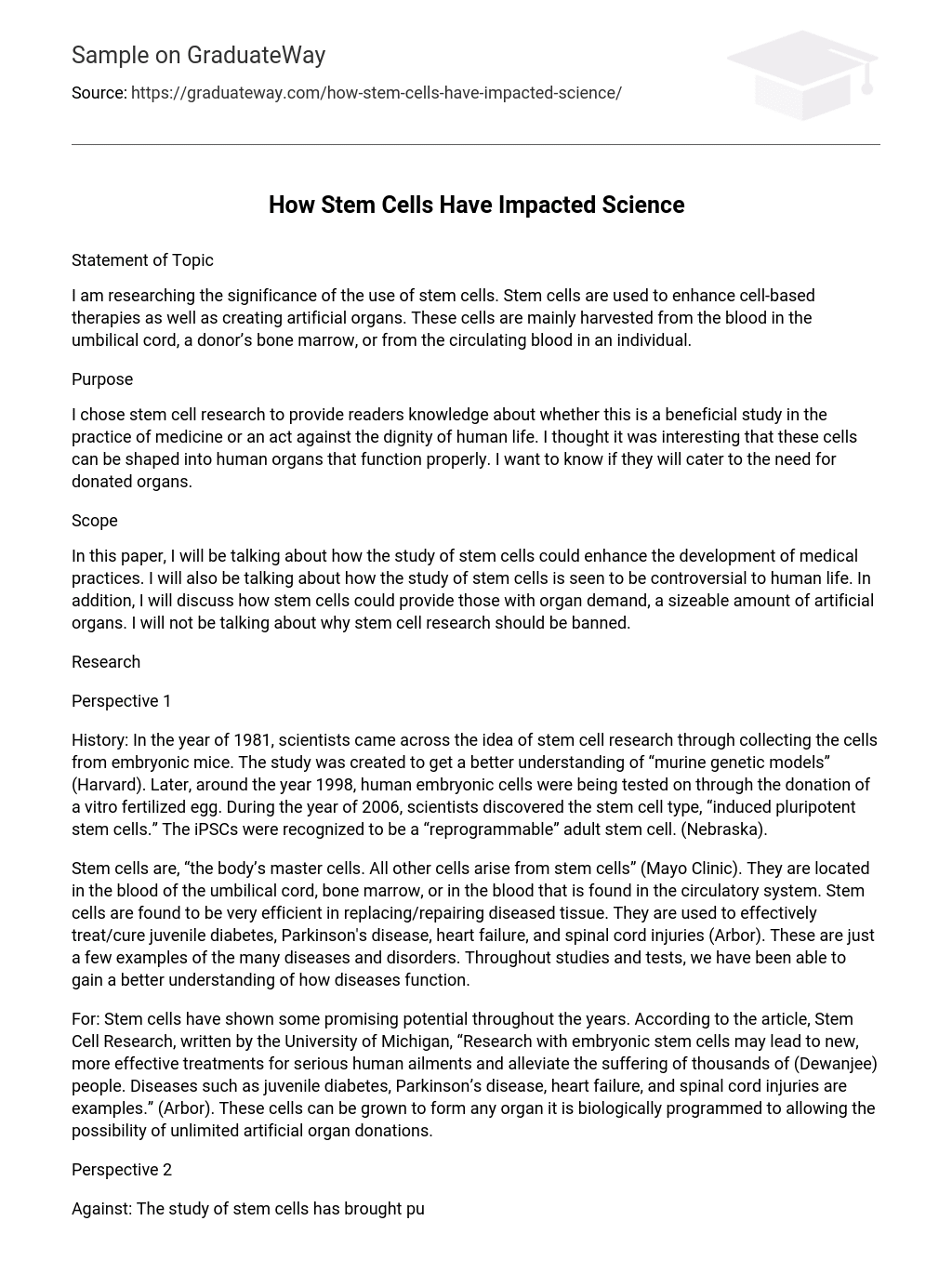Statement of Topic
I am researching the significance of the use of stem cells. Stem cells are used to enhance cell-based therapies as well as creating artificial organs. These cells are mainly harvested from the blood in the umbilical cord, a donor’s bone marrow, or from the circulating blood in an individual.
Purpose
I chose stem cell research to provide readers knowledge about whether this is a beneficial study in the practice of medicine or an act against the dignity of human life. I thought it was interesting that these cells can be shaped into human organs that function properly. I want to know if they will cater to the need for donated organs.
Scope
In this paper, I will be talking about how the study of stem cells could enhance the development of medical practices. I will also be talking about how the study of stem cells is seen to be controversial to human life. In addition, I will discuss how stem cells could provide those with organ demand, a sizeable amount of artificial organs. I will not be talking about why stem cell research should be banned.
Research
Perspective 1
History: In the year of 1981, scientists came across the idea of stem cell research through collecting the cells from embryonic mice. The study was created to get a better understanding of “murine genetic models” (Harvard). Later, around the year 1998, human embryonic cells were being tested on through the donation of a vitro fertilized egg. During the year of 2006, scientists discovered the stem cell type, “induced pluripotent stem cells.” The iPSCs were recognized to be a “reprogrammable” adult stem cell. (Nebraska).
Stem cells are, “the body’s master cells. All other cells arise from stem cells” (Mayo Clinic). They are located in the blood of the umbilical cord, bone marrow, or in the blood that is found in the circulatory system. Stem cells are found to be very efficient in replacing/repairing diseased tissue. They are used to effectively treat/cure juvenile diabetes, Parkinson’s disease, heart failure, and spinal cord injuries (Arbor). These are just a few examples of the many diseases and disorders. Throughout studies and tests, we have been able to gain a better understanding of how diseases function.
For: Stem cells have shown some promising potential throughout the years. According to the article, Stem Cell Research, written by the University of Michigan, “Research with embryonic stem cells may lead to new, more effective treatments for serious human ailments and alleviate the suffering of thousands of (Dewanjee) people. Diseases such as juvenile diabetes, Parkinson’s disease, heart failure, and spinal cord injuries are examples.” (Arbor). These cells can be grown to form any organ it is biologically programmed to allowing the possibility of unlimited artificial organ donations.
Perspective 2
Against: The study of stem cells has brought public attention to whether it is an ethical practice or not. The process of harvesting embryonic stem cells is viewed by some as unethical due to the destruction of living embryos for scientific research. In the article, Stem Cell Research: An NPR Special Report A ‘Virtual Roundtable’ on Federal Funding, David A. Prentice states that Current Federal Law will prohibit “Research in which a human embryo or embryos are destroyed, discarded, or knowingly subjected to risk of injury or death.”
Personal Perspective
The University of Utah has granted me permission to present a lecture on Stem Cell Research in order to bring forth valuable scientific studies. I will be collaborating with medical students, scientists, and professors found at the University who study bioengineering in order to give factual information amongst our audience. They will be paid to educate our audience about the subject. We are welcoming 250 guests to this lecture to those who are interested. The event will be held in the library of the university.





